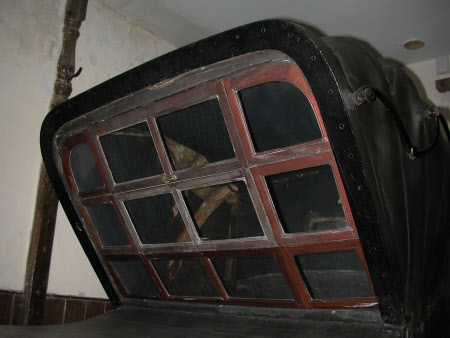Barouche
Turrill and Sons
Category
Carriages & other vehicles
Date
1830 - 1840
Materials
Painted wood body with leather hood, wool cloth and leather upholstery and four iron shod wheels.
Measurements
235.5 x 371 x 174cm (7ft 8 3/4in x 12ft 2in x 5ft 8 1/2in)
Place of origin
London
Order this imageCollection
National Trust Carriage Museum
NT 272886.1
Caption
This style of Barouche was designed for long distance travel. In addition to the folding head, this carriage also had a “water deck” and a screen of small glazed windows to protect the occupants from the elements. What made this carriage so versatile was that everything could be folded away when they were not needed, thus making it suitable for fine weather and town driving. This carriage would be coachman driven in town and postillion driven by post boys during long journeys.
Summary
Travelling Barouche built for the Marquess of Bute by Turrill of Long Acre, London between 1830 and 1840. Travelling Barouche (four wheels) for a pair or team of horses. The body is sprung on full elliptic and rear leaf springs. A glass fold down screen protects the passengers from inclement weather. The interior trim is in dark blue, with a rubber driver's footpad. Painted in dark green and black livery with red lining.
Full description
This carriage could be either coachman or postillion-driven and was used for making long journeys. As on all barouches, only the principal seat at the back of the body is protected by the folding leather head. There is another seat at the front which was only used in fine weather, when the knee flap would be raised to form a seat back. This example has a series of hinged boards, known as a water deck, which can be folded up and strapped onto the knee flap. When they are unfolded they protect the legs of the occupants, who have the additional protection of a screen of small glazed windows. These can be folded together and strapped into the head frame when they are not needed. The coachman’s seat board is actually two boards, and the top one can be hinged over to make a large platform to carry luggage. Like the travelling chariot it has a sword case. This carriage, which is another that was donated by the Marquis of Bute, was built by Turrill of Long Acre, London, who built most of the Bute family carriages. In the first guidebook for the National Trust Carriage Collection written by Hugh McCausland, he named this carriage an 'Open Travelling Carriage or Britzschka' although it is much more accurately described as a travelling barouche. Mc Causland said it was the 'open or fine-weather equivalent of the closed travelling coach having been used in the same way and for similar purposes, except that was a carriage more generally suited to Continental travel in climates warmer and finer than that of England, the folding head (hood) providing shelter for only two passengers. The perch in this example is of iron which suggests its use in the eighteen forties or fifties, earlier perches having been timber.'
Marks and inscriptions
On front nearside axle components.: C On front offside axle components.: C On rear nearside axle components.: C On rear offside axle components.: C On front nearside axle components.: EVANS & SON MAKERS LONDON On front offside axle components.: EVANS & SON MAKERS LONDON On rear nearside axle components.: EVANS & SON MAKERS LONDON On rear offside axle components.: EVANS & SON MAKERS LONDON
Makers and roles
Turrill and Sons, coach builder


